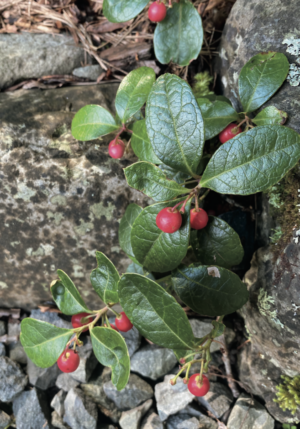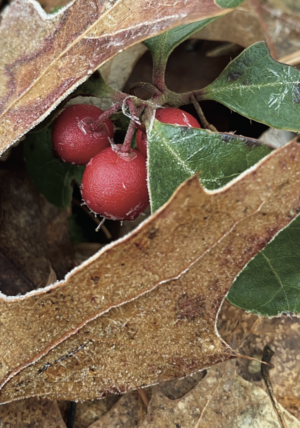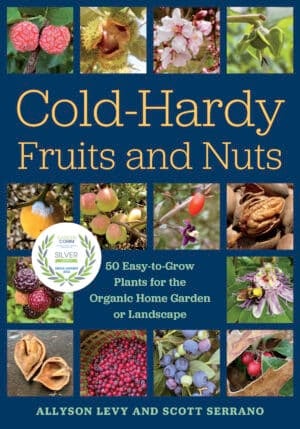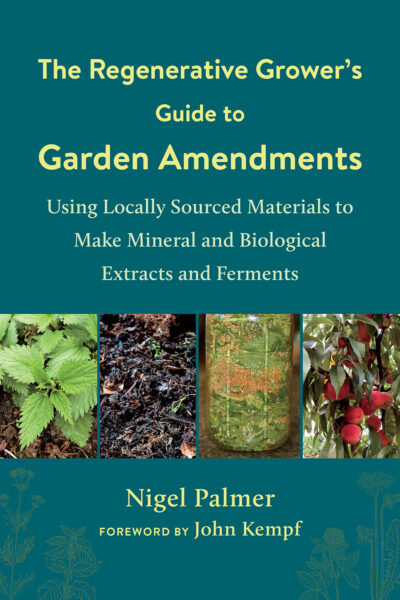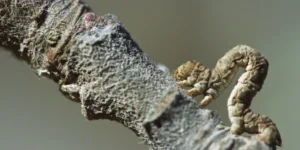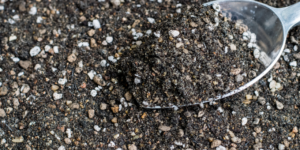Wondrous Wintergreen: All About the Wintergreen Plant
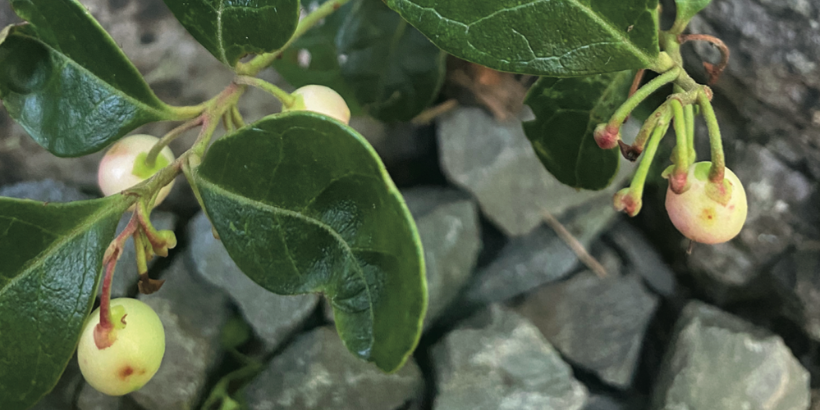
Have you ever chewed on a piece of gum or used toothpaste and wondered where the minty taste comes from? It’s all in the wintergreen.
Wintergreen, a vine that produces flavorful berries, is very easy to grow and harvest in your own garden or greenhouse. Here are some tips for growing this cold-hardy plant, along with a bit of historical background.
Unless otherwise noted, all photographs copyright © 2022 by Allyson Levy and Scott Serrano.
The following is an excerpt from Cold-Hardy Fruits and Nuts by Scott Serrano and Allyson Levy. It has been adapted for the web.
Wintergreen (Gaultheria procumbens)
Checkerberry, Teaberry
Once I was taking a young lady student from Sweden for a walk through some woods in central Pennsylvania. I picked some Wintergreen berries for her to taste . . . She did, then exclaimed, “There’s that American taste again! It is in the chewing gum, candy and toothpaste, and now it is in the plants and trees that grow over here.”
—Euell Gibbons, 19621
That distinctive “American taste” is the rich, aromatic flavor of wintergreen, a sharp root-beer-like flavor contained in the foliage and berries of the plant.
These humble but attractive creeping vines are a common species throughout the lower parts of eastern Canada and down the East Coast as far as Georgia, and across to midwestern states such as Wisconsin and Minnesota.
Wintergreen is a creeping, mat-forming vine that inhabits cool, shaded forest areas, surrounded by many types of understory plants such as moss, mountain laurel, and huckleberry, which all thrive in the dark, acidic soil, created by the tree canopy of pine and oak trees, combined with other hardwoods.
The History of Wintergreen
There are over 130 species of plants in the Gaultheria genus, evergreen shrubs and creeping vines that are mostly found in subtropical areas of Asia, Australia, New Zealand, and North America from Canada down to Chile.2 Five species are native to the woods of the United States.
In the eighteenth century, the French Canadian court physician Dr. Hughes Gaultier wrote about his love of wintergreen tea and said that he had “. . . discovered the Canada Tea . . . which he created as an excellent drink.”
The Swedish explorer Peter Kalm visited his friend Gaultier in 1748, and because of the doctor’s enthusiasm for this group of plants, Kalm proposed that this genus should be named in honor of his friend. This idea has “botanically stuck,” hence the name Gaultheria.3
Wintergreen Flavoring
Until modern chemistry created synthetic flavors for consumer commodities, many common household products used to contain wintergreen oil as a popular flavor ingredient, such as toothpaste, medical products, soaps, vermouth, perfume, shaving cream, and root beer.
But most people associate wintergreen’s aromatic flavor with two popular early American candies: wintergreen Life Savers, which were introduced in 1919 by the Life Savers candy company; and Tea- berry chewing gum, which was created by the Clark Brothers Chewing Gum Company in 1921.4
Growing Wintergreen: A Guide
We love this old-fashioned flavor, frequently utilize this plant, and think that if you like the taste of wintergreen, you should try growing these creeping vines that thrive in the shade where few other food plants can survive.
Growth Difficulty Rating
1. Wintergreen is an easy plant to grow that is fairly pest-free and will thrive in almost any shady growing area that has acidic soil.
Wintergreen Taste Profile and Uses
Wintergreen berries are an attractive scarlet-red color and ripen in the fall but will persist on plants throughout the winter. The fruits become sweeter after being exposed to some frosts and cold, but by the end of the winter these berries start to dry out and are less palatable.
The round fleshy berries are produced near the ends of the stems and grow about 3⁄8 inch (1 cm) in diameter, and both the fruit and the leaves contain the same aromatic menthol flavor. The berries are mildly sweet with a distinctive flavor.
Tender young leaves can be eaten as a snack, but are best used as tea or for brewing root beer. The leaves contain a volatile oil that will dissipate and weaken if boiled too long.
For the best results, place the clean leaves into a saucepan with water and bring to a boil, then remove the pan from the heat and allow the leaves to steep for several hours to increase the flavor. The strained liquid tastes like root beer when combined with a sweetener.
Plant Description
Wintergreen is a spreading, low-growing shrub that slowly forms into a low, wide carpet through rhizomes (underground shoots), which spread at a depth of 1 inch (2.5 cm) below the soil level.
The creeping branches grow stems that are 2 to 6 inches (5.1–15.2 cm) high and bear attractive, deep green, 1- to 2-inch (2.5–5.1 cm) oval or elliptical leaves, with a smooth leathery texture.
The leaves are evergreen and acquire a red blush through the winter, and the cold temperatures reduce the amount of the aromatic oils in the plants, so it’s better to harvest the foliage for tea and root beer from summer through the late fall.
The plant’s leaves and berry displays can be used as a wonderful ground cover around taller acid-loving plants such as pine trees, rhododendrons, and huckleberries.
Wintergreen grows slowly and its root systems are easily damaged if they are pulled out of the soil, so take care that the plant stays in place when you harvest the leaves.
Flowers
Small, nodding, bell-shaped white or pinkish white blossoms are formed out of five overlapping petals fused at the tips, which are 1⁄4 to 3⁄8 inch (0.6–1 cm) long and generally produced singly at the base of the leaves in early summer from June to July.
Wintergreen Pollination Requirements
The flowers are self-fertile, but a large group of wintergreen should be sited together to produce a substantial harvest of the berries.
An added benefit to planting a lot of this slow-growing plant together is that it will provide a large quantity of leaves so that you will not entirely strip the plants of their foliage when harvesting them for tea.
Site and Soil Conditions
The plants require an acidic soil, but average garden soil can be amended with acidic organic materials such as broken-down pine needles or oak leaves, or the duff found below pine and oak trees.
Wintergreen is adaptable to sandy soil as well as areas that have a heavy clay content, but the planting site must be well drained because the plant’s root systems can rot when they grow in waterlogged conditions.
Wintergreen does well around mosses and likes similar growing conditions that are shady with a consistent amount of moisture throughout the year, although after the plants have been established for a few growing seasons, they are more drought-tolerant.
Wintergreen will grow in full shade, but it does not yield large amounts of flowers and fruits in dense shade. The plants will be more productive when they are sited where they can receive a few hours of sun in morning or in the late afternoon, with shade during the hottest part of the day.
Bright shade near the edge of a tall tree line that receives lots of filtered light would also be a better choice than deep shade in the middle of a forest.
Hardiness
Wintergreen is rated hardy to zone 3, or to −40°F (−40°C).
Wintergreen Fertilization and Growth
Wintergreen will benefit from a periodic mulch of pine needles to keep its shallow roots cool and to keep the soil acidic.
Wintergreen is in the large family called Ericaceae; all the plants in this family like acidic soil conditions and would benefit from being enriched every two or three years with a small amount of a soil amendment, such as pine duff or a commercially produced organic amendment sold in nurseries for fertilizing rhododendrons and blueberries, which are in the same family as wintergreen.
Cultivars
For many years this plant was ignored by the nursery trade; then a decade ago nurseries began to sell wintergreen as an ornamental ground cover for shady areas.
Several years ago plant breeders started to create a handful of cultivars that were selected for larger fruit sizes, berry colors, and yields as well as decorative foliage, and we have listed a few of these newer cultivars.
‘Berry Cascade’: A trademarked productive variety that produces fruits along the entire stem of the vine, instead of just on the ends of stems.
‘Cherry Berries’: A cultivar selected for extra-large, showy wintergreen berries.
‘Winter Fiesta’: A newer cultivar that was selected for its bright white wintergreen berries with a pink blush.
Related Species
The wintergreen genus includes four other plants that are native to the United States: Gaultheria humifusa (Alpine wintergreen), G. ovatifolia (Oregon spicy wintergreen), G. hispidula (creeping snowberry), and G. shallon (salal).
These are all part of the Ericaceae family, which includes over four thousand species distributed all over the world. Wintergreen is related to a diverse group of plants such as cranberry, rhododendron, manzanita, heather, and mountain laurel.
Wintergreen Propagation
Wintergreen can be grown from seeds that are potted up in soil and cold-stratified (exposed to cold) for two to three months to induce them to germinate.
The easiest way to generate new plants is to divide old, established wintergreen colonies by gently digging up a small section of the shrub that has some roots attached to it, and potting it up with acidic, well-drained soil for a few sea- sons until it has grown a larger root system for transplanting.
Another easy method for propagating plants is to layer a section of the branch under a small mound of soil to encourage roots to form; after a season or two, this part can be cut away from the mother plant and potted up.
Pests and Problems
The plants are not bothered by many pests, but the berries do occasionally get taken by wildlife.
Caution
Wintergreen was used as a natural form of pain relief because all of the parts of the plants contain methyl salicylate, which is a natural aspirin-like chemical.
Using small amounts of the leaves and berries for brewing drinks is safe, but people who have an allergic reaction to aspirin should exercise caution when using the leaves.
Wintergreen Oil
Commercially produced wintergreen oil is a common herbal medical product used as a natural remedy for sore muscles because of its beneficial anti-inflammatory properties.
But this type of oil contains chemically distilled oils whose methyl salicylate is much stronger than the leaves of the plant.
It can be used only as a topical skin cream, and is considered highly toxic and dangerous to ingest in any form!
Notes
1. Euell Gibbons, Stalking the Wild Asparagus (Putney, VT: Alan C. Hood, 1962), 212.
2. Roger Phillips and Martyn Rix, The Botanical Garden (Buffalo: Firefly Books, 2002), 206.
3. Merritt Lyndon Fernald and Alfred Charles Kinsey, Edible Wild Plants of Eastern North America (New York: Harper & Brothers, 1958), 309; L. H. Bailey, The Standard Cyclopedia of Horticulture, vol. 2, 3rd ed. (New York: Macmillan, 1930), 1318.
4. Cybele May, “Life Savers Pep-O-Mint & Wint-O-Green,” Candyblog (November 1, 2010), http://www.candyblog.net/blog /item/lifesavers_pep-o-mint_wint-o -green; Cybele May, “Classic Gums: Black Jack, Clove, Beemans & Teaberry,” Candy- blog (June 10, 2009), https://www .candyblog.net/ blog/item/classic_gums.
Recommended Reads
Recent Articles
How do you control bugs & pests on your fruit trees without using harmful sprays and treatments? Here are some tips for identifying insects on fruit trees and controlling them organically. The following is an excerpt from The Holistic Orchard by Michael Phillips. It has been adapted for the web. Finding Insects On Fruit Trees…
Read MoreLooking for ways to naturally enrich your garden? The answer is all around you….literally. Add local rocks & soil to your garden to improve soil health and see your crops flourishing in no time. The following is an excerpt from The Regenerative Grower’s Guide to Garden Amendments by Nigel Palmer. It has been adapted for the…
Read MoreGarden strawberries are excellent for both covering the ground and for growing fruit. If you’re planning out a forest garden, or are just looking for a plant to use as ground cover, strawberries are a great option. The following is an excerpt from The Home-Scale Forest Garden by Dani Baker. It has been adapted for…
Read MoreAsparagus is a delicious vegetable with a layered history. How did this aspiring spear make its way from growing in the wild to appearing on our plates? The following is an excerpt from the The Seed Detective by Adam Alexander. It has been adapted for the web. “Nature gives us the key to every secret…
Read MoreInterested in growing trees? Here are some tips on successfully planting, transplanting, and pruning trees to create a flourishing forest garden! The following is an excerpt from The Home-Scale Forest Garden by Dani Baker. It has been adapted for the web. Planting Potted Trees and Shrubs If you order potted trees, check with your supplier to…
Read More



